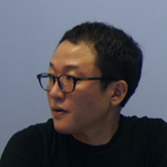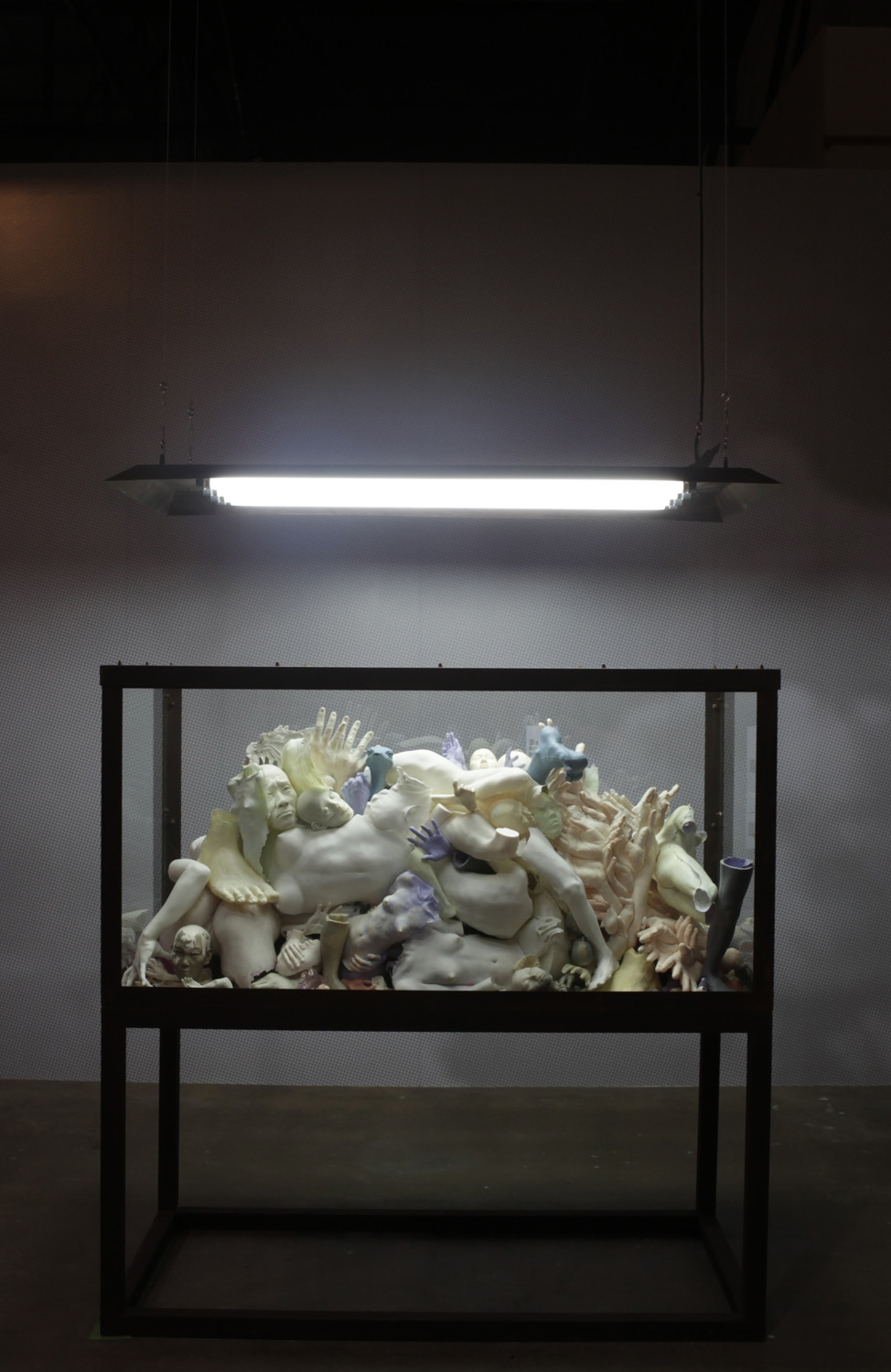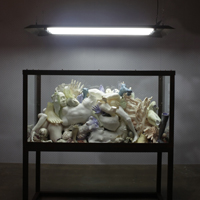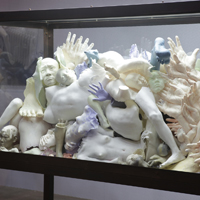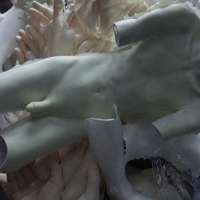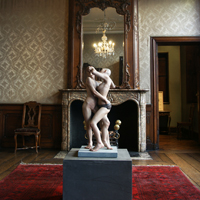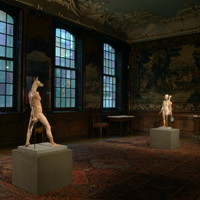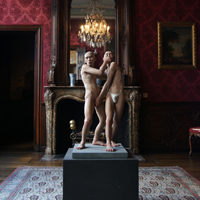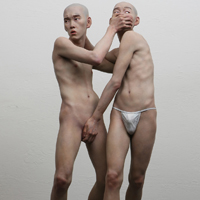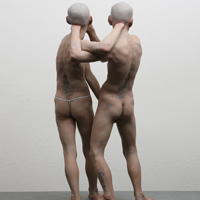A Shaman of Our Time, Xooang Choi
Xooang Choi is an artist who sculpts concrete bodies. This may sound somewhat banal at first, but we come to be surprised at his ability to grasp the world pathologically. Choi’s understanding of the world began with his 10-20 cm miniature figures displayed at this first solo show. These miniature figures, suffering from an expansive delusion, do not realize their relative diminutiveness, and tend to overstate their ability and situation. They have a bloated musculature, partly enlarged bodies in macho-like gestures suited for revealing such megalomaniacal symptoms. Their effort to emphasize their existence through bragging and exaggerated gestures at times seems pompous, but they are too diminutive to impact the world, despite their attempts.
Choi’s concern with society’s pathological state later moved to an interest in vegetative states those making utmost efforts in living everyday life undergo. A person in a vegetative state cannot perceive or affect his surroundings at all due to serious brain damage, although he looks like he's breathing, laughing, weeping, and awakening himself. Choi likens an individual’s mental state intimidated by an unidentified force, to a person in a vegetative powerless state. The artist’s perception of this state is confirmed in the work titled Vegetative State displayed at his second solo show. A bare tree grows from the head of a vulnerable man who has fallen down. This work, depicting a man changing into a vegetative state, like Daphne who transformed into a laurel, appears realistic and elaborate in its finishing, through its amazing figurative imagery and the meaning of the title.
In his second solo exhibition Choi saw contemporary people as vegetative persons in a state where they can do nothing by their free will in a highly standardized, controlled society, Choi now uses his accute sensibility to shed light on how an individual’s deeds and consciousness influences society and others. Choi’s third exhibition entitled Itching refers to symptoms causing persistent scratching or rubbing the skin. In this exhibition Choi diagnoses our state, likening this pathological state to a human’s mental condition.
A message he wants to convey through the exhibition is that our current condition is not caused merely by external elements. In the same way we try to momentarily relieve itching by the repeated act of rubbing the skin, aggravating the situation, we often resort to rash measures to remedy social inconvenience and irrationality. This recognition is confirmed in The Wing depicting a wing with innumerable rough hands. As an enormous ideal is only completed through the efforts of each anonymous person, the sacrifice of an individual is indispensable for any social progress. It is cruel for each individual, but this kind of sacrifice has continuously been required for the achievement of social ideals.
Since the third exhibition, Choi seems to focus on the individual rather than any systematic problems. The artist has examined the dual meaning of each individual’s activities seemingly based on their own free will, and the accomplishments of a society’s ideals through their sacrifice. In Asperger Island however, Choi highlights the formation of social characters based on each individual’s personality. Through the pathological term ‘asperger’, referring to a state of impairment in social interactions, he visually represents human’s universal attributes, unveiling our social persona and concealed human desires.
Choi visualizes the properties of each individual through one spreading rumor, one who has a huge head too heavy to stand up, one who begs for money with huge hands, one who has an extraordinary sense of smell, and one who has huge feet. In this series, Choi employs a partly hyper-realistic technique as well as other methods of exaggeration, abbreviation, and modification, using his own formative language.
While Choi’s work arouses our admiration with its extremely realistic rendition, in a sense his figures, at times seem pessimistic in that aspects of our lives and times are shown only in pathological terms. However, we can call him a shaman. Choi’s work has the power to make us look closely at our world and situation. Although his pieces do not present any strategies for healing, we can expect his following work will lead us to make efforts towards healing.
Ki Hye-kyung (Curator of National Museum of Modern and Contemporary Art, Korea)
Condition for Ordinary Exhibition Forward
In 2007, Xooang Choi held a solo exhibition titled 'The Vegetative State'. Choi has continuously explored ordinary people and the social milieus in which they live. His interest centers around how social systems– asthey become both accelerated and urban centers expand–becomemore standardized in order to manage and control people more effectively. Most people have no choice but to adapt to these changes, and some – without their knowledge – are brought to a standstill (become helpless),a condition Choi has termed “The Vegetative State”. The sculptures in his embody this “state”,drooping almost lifelessly and appearing resigned, as if they are suppressed by a great force.
In 2009, Choi presented two works ;The Wings(2009)'and 'The Hero(2009)', both of which reveal his interest in the issue of “microfascism”. The French philosopher Felix Guattari’s analysis of capitalism and fascismnoted that figures of authority in a capitalist society try to control the population by making their values internalized by the masses. That is to say, what the society desires is induced, and the masses in turn follow the desired actions voluntarily. Even though it may appear that thosefollowing authority desire something forced upon them by an outside entity, the desires may in fact be their own.
The military regime that governed Korea during the 1960-70s emphasized the value of the collective over the worth of a single individual under the guise of growing the industry and economy. The people of this generation followed the direction established by the authority figuresand regarded themselves the protagonists and heroes of Korean society’s progress. However, as time passed, thishistoric era has been (re)assessed,raising the question of whether its generation was in fact heroic or if they had been manipulated by the ruling party. The Heroes and The Wings specifically address these longstanding issues.
In the works mentioned above, Xooang Choi began examining the relationship between the collective and the individual, exploring issues of generation, ideology, and history. In later works, Choi focused onobserving the relationships between different social groups rather than trying to classify an individual within the collective. Following the insight of French postmodernists like Guattariand Michel Foucault, Choi developed his own insight into how collectives disregards certain characteristics of an individual in an attempt tointegratethem a single unified stream. In this context of fascism,whatever does not fit in the mainstream is deemed abnormal. It was this tension that prompted Choi to develop two distinct bodies of work, the 'Islets of Aspergers (2009)' and 'Speaker (2011)' and 'Listener (2011)'.
First, Choi took interest in social minorities. In his series Islets of Aspergers, he focused on people who have Asperger’s syndrome. Asperger’s syndrome is characterized by individuals who have difficulty integrating into mainstream society and lack basic social communication despite normal linguistic and cognitive development. Those displaying this syndrome may also be sensitive to sensory stimuli such as sound, light, smell, and taste, and they have a tendency to become intensely focused on idiosyncratic subjects, sometimes displaying an outstanding gift in a specific subject. Given the broad definition of Aspergers, Choi asks the question: is it possible that certain individuals are described as outside the norm and suffering from psychological conditions based solely on their behaving outside the norm?Anybody can become immersed in a certain subject, and there may be a difference in intensity and focus, but this is the kind ofdistinction which separates certain individuals further from social norms and not the basis for medical condition.
Second, Choi has explored the issue of perspective, focusing on the two roles of Speaker and Listener. Exhibited as a pair, his sculptures show a male figure (Speaker) with his hand raised, suggesting that he is saying something, while the female figure (Listener) sits passively and listens to the speaker. The artist has depicted the hand and the mouth of the male figure and the ears of the female figure clearly, while the rest of the body was sculpted to appear blurry. In addition, the figures are clothed, an unusual feature in Choi’s work.
At first glance, the Speaker on the higher pedestal seems to dominate the Listenerwho occupies a lower pedestal. One would assume that the former holds the power. However, this is not the only viable interpretation of the work. While the female Listener sits comfortably wearing loose track pants, the male Speaker stands in a precarious position, wearing a tight pair of jeans. Moreover, most viewers would consider the clearly defined areas of the body more important, but the rest of the body rendered indistinctly reveals that the listener appears more composed and relaxed than the speaker. As such, power can easily shift depending on the point of view — a point that informs Choi’s critique; thatsocial minorities are created from similarly arbitrary viewpoints.
Recently, Xooang Choi’s work has begun to explore explicitly “ordinary”subjects. Although themes of society, collective and cultural structures are important, it is always made up of individual “humans”. Choi sculptures frame the importance of these individual traits examining self-awareness and the inner conflicts of ordinary people, focusing in particular on the ways these elements manifest in the subjects’ physical stature. By presenting two bodies at the same time, the artist visualizes the subtle psychology and attitudes of individuals through the dichotomies of the subject and object, active and passive, dominant and submissive, exposed and hidden, variable and constant.
Comprised of two female figures, the work 'Reflection(2012)' addresses “self-awareness”. The work presents a woman looking in the mirror and the shape of her body reflected in the mirror. One figure is rendered clearly but the other remains indistinct. It is easy to look at the pair and say that the clearly defined form is the actual model and the blurry form is the mirrored image, yet the opposite is true. The viewer can recognize this by looking at the tattoos on her arm, ankle, and waist. The model may have seen a reversed image of herself in the mirror many times, but she has probably has never seen herself reversed three-dimensionally. A mirror shows our reflection as an exact copy but nevertheless still a reversed image, different from our actual appearance. In this same way, humans have difficulty perceiving their bodies and personalities accurately. Humans are more likely to be familiar with looking at themselves through another’s gaze rather than their own. The model in Reflection has gently turned her head to look at herself and one can see that her expression shows cautiousness, curiosity, and surprise.
In another work, 'Isometric_Male(2013)' is also formed of two figures. They are in fact the same person. The same applies for 'Isometric_Female (2013)'. The two male figures depicted in 'Isometric_Male' put their hand atop each other’s head. The naked man covers the mouth of the other, while his male counterpart who is wearing panties covers the genitaliaof his companion. In a similar manner, the two women depicted in 'Isometric_Female' place their hands on one another’s heads. The woman wearing panties covers the eyes of her mirror imagewhile she in turn places her hand inside her companion’s panties.
The sculptures reveal a scene reminiscent of a puppet show because their hands are placed into the head of the other almost as if they were directing them. But because both figures are doing the same thing, it is difficult to discern which one is human and which is the marionette. One man wants to say something but he is unable to do so because his mouth is covered. The other man wants to expose himself but his sex is covered by his opposite’s hand. To say something and to cover one’s mouth, to reveal and to be covered up at the same time, this reveals the inherent inner conflict of the individual.
'Settlement(2012)' and 'Colonization(2013)' reflect on the “changeability of the body”. Though historically the human body was believed to be fixed, inviolably determined at birth, recent development in medicine and plastic surgery has made it possible to change a part of the body or even get an organ transplant from another. These changes have affected both the attitudes and awareness of humans as well as the definition of what being human is. Many people now consider a body to be infinitely changeable. In the future, a human body may be combined with artificial organs, machines, and even artificial intelligence. And when this happens, the definition of the body, subject, and awareness will also be completely transformed.
Settlement is a sculpture made up of a combination of completely disparate anatomical parts from humans, animals and objects. In particular, the face is awkward;if one assumes that the human is wearing a mask skull, then it would not be possible for the teeth of the skull to appear more in-set than the lower lip. Or if one supposes that the skull is the subject, then it would appear that the skin had been transplanted onto the skull. Together this highly refined and surreal hybrid humanmakes it difficult to determine whether it is a living being or ifthe skull is the subject.
The rear view of 'Colonization' is also unsettling due to the corset-like strings tied to the back of the sculpture. It looks like an item of clothing but it is indisputably joined at the stomach. Moreover, the figure is wearing shoes, but the tips of the shoes are actually toes. Again, it is difficult to distinguish which part is a human body and which part is an object. It is also difficult to separate the subject and the object.
Ryu Hanseung (Curator of National Museum of Modern and Contemporary Art)






